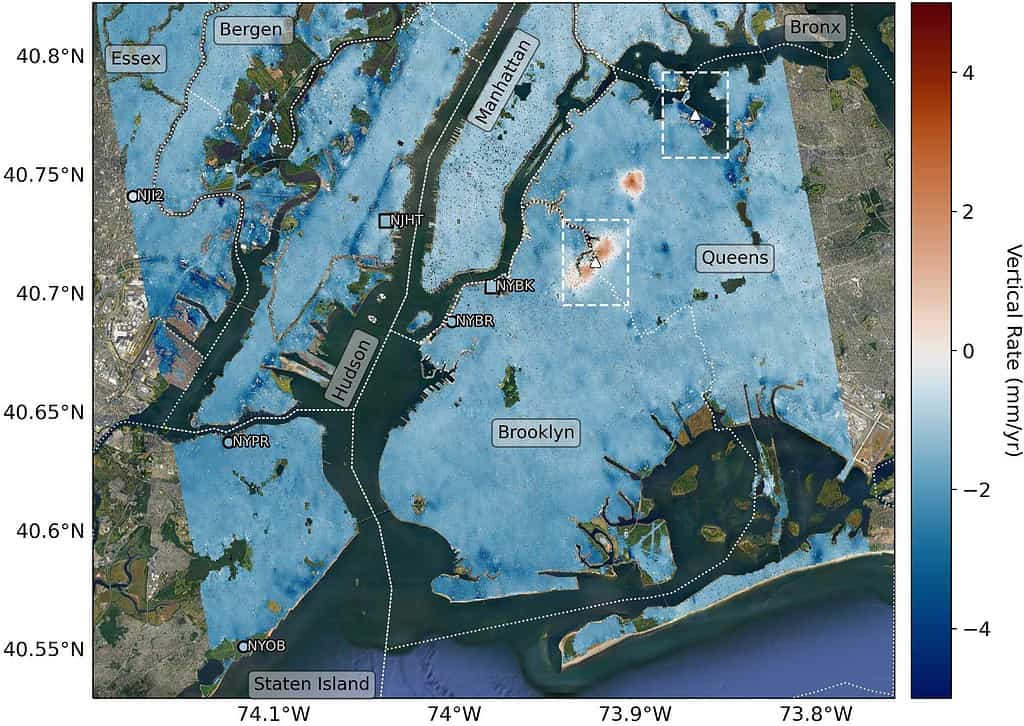Big parts of New York City are sinking at different rates. This was first reported earlier this year, when researchers theorized that the weight of skyscrapers may have a role to play. Now, researchers from NASA’s Jet Propulsion Lab used satellite images to analyze this in more detail. They found that New York’s sinking is due to factors ranging from long-lost glaciers to land-use practices. While the changes may seem small, less than 2 millimeters per year, they can alter local flood risk related to sea level rise.

The researchers, together with a team at Rutgers University in New Jersey, analyzed upward and downward vertical land motion across the metropolitan area. They used a technique called interferometric synthetic aperture radar (or InSAR). InSAR combines two or more 3D observations of the same region to reveal upward or lateral motion or topographic changes.
The eye in the sky
A big part of the motion observed happened in places where prior changes have made the ground looser and more compressible. In particular, projects such as landfills or land reclamation make the ground more susceptible. So when you come and later build over such soils (particularly heavy buildings like skyscraper), you’re at a higher risk of soil compression and sinking.
However, some of this sinking was also caused by natural processes that date back thousands of years to the most recent ice age.
About 24,000 years ago, a vast ice sheet extended over most of New England, with an ice sheet of over a mile in height enveloping present-day Albany in upstate New York. Since then, the Earth’s surface has been gradually readjustingNew York City, on land that was elevated outside the edge of the ice sheet, is presently undergoing subsidence because of this.
The researchers found that on average the metropolitan area has subsided by about 1.6 millimeters (0.06 inches) per year. This is similar to how much toenails grow by each month. Using the radars on the ESA Sentinel-1 satellites, they mapped the motion in detail and pinpointed the neighborhoods and landmarks that are subsiding faster than average.
“We’ve produced such a detailed map of vertical land motion in the New York City area that there are features popping out that haven’t been noticed before,” lead author Brett Buzzanga said in a news release. Tracking elevation changes and sea level changes is very important for flood mapping amid Earth’s changing climate, pushing oceans higher.
The sinking hotspots
The researchers identified two major hotspots of subsidence. The first one is the runway 13/31 at LaGuardia airport, where the land is sinking faster than average (3.7 mm). The airport is now going through a renovation to partly alleviate flooding from the rising waters of the Atlantic Ocean.
The second hotspot is the Arthur Ashe Stadium, where the US Open is held every year. The stadium is sinking at a rate of 4.6 mm per year and in fact, required construction of a lightweight roof to reduce its heaviness. Both the runway and the stadium were originally built atop landfills, which explains the higher-than-average rates.
Other hotspots include the southern part of Governors Island, which was built on 3.5 million cubic meters of rock and dirt from early 20th-century subway excavations, as well as sites close to the ocean in Coney Island in Brooklyn. High levels of sinking were also reported below Route 440 and Interstate 78 in New Jersey and Rikers Island.

But not all of New York City is sinking.
The researchers were also surprised to find some places in New York where the land is actually rising. In East Williamsburg, Brooklyn, the land is moving up by about 1.6 mm per year. Meanwhile, in Woodside, Queens, the land rose 6.9 mm per year between 2016 and 2019 before finally stabilizing.
For close to two centuries, water levels in the New York City area have been increasing at an approximate rate of 0.11 inches annually (0.28 cm). The city recently made the news because of flash flooding, which led to a state of emergency. Up to 20 cm (around 7.9 in) of rain fell in some parts of the city, with the subway, streets and highways flooding very fast.
The researchers believe that many cities currently investing in coastal defenses and infrastructure to respond to sea level rise, such as NYC, can benefit from high-resolution estimates of land motion, as seen in this study. That’s why they will continue looking at surface displacement across North America, using new data.
The study was published in the journal Science.


